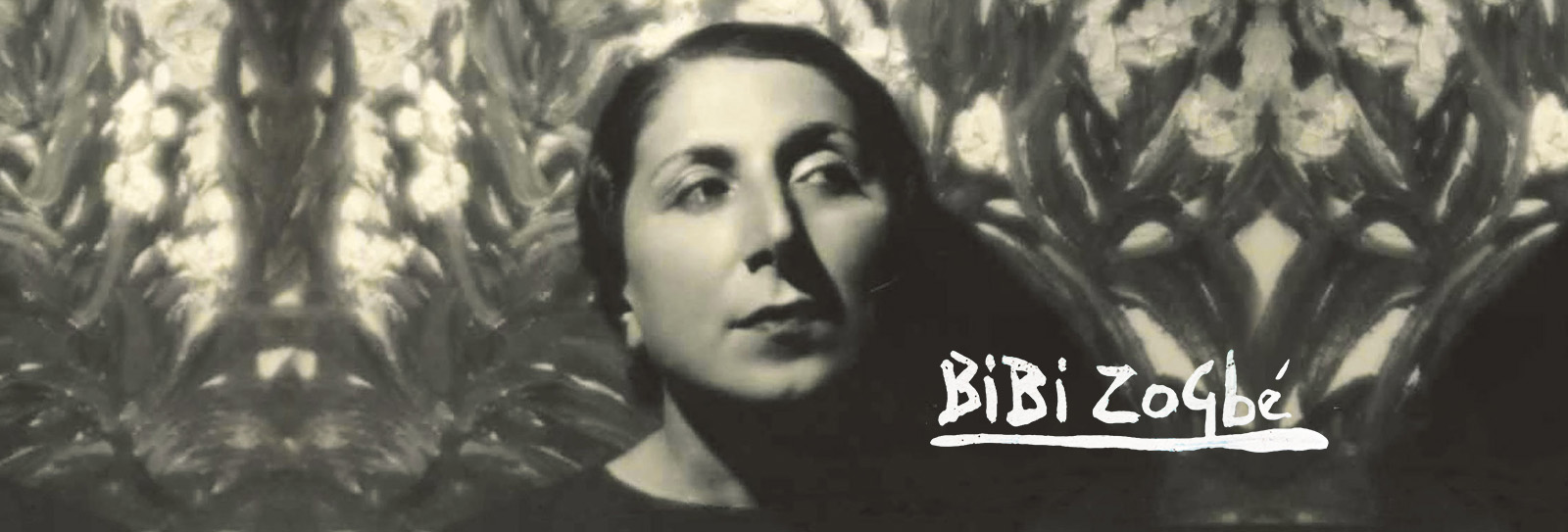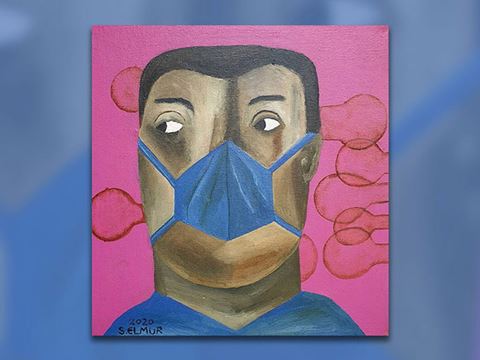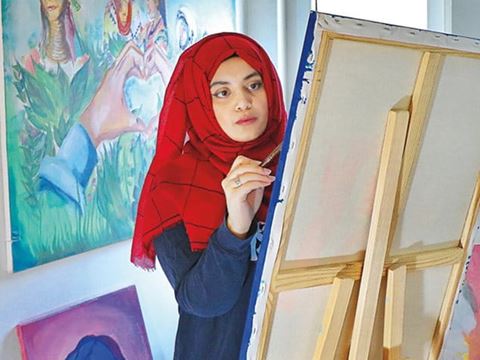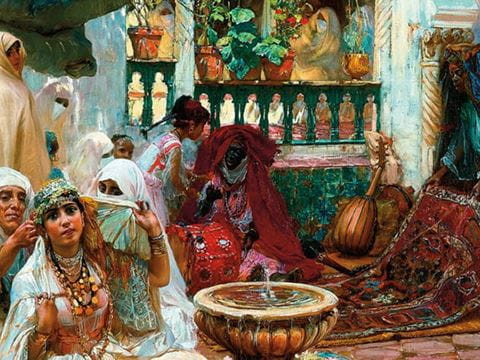
A Quest To Discover Lebanon's Bibi Zogbé, Painter of Vibrant Hues
Except for a rare self-portrait, Bibi Zogbé painted flowers—exuberant and confident, as well as modern and symbolic, her paintings reflect her life between her native Lebanon and three decades in Argentina.
12 min
Written by Dianna Wray Photographed by George Azar Art courtesy of Saleh Barakat
It was the vibrant hues in the painting that first drew his eye almost 20 years ago, recalls Beirut art gallerist Saleh Barakat. It was one painting amid a shipment of works that arrived for sale at his Agial Gallery, all of them painted by artists from Lebanon’s modern art movement. The shades of emerald, cornflower blue and chestnut, rendered by thrusting gobs of color on the canvas, made him do a double take, all without a hint of hesitation. The painting showed a simple garden of Lebanese cacti, but the painter’s strokes were strikingly confident, and in style it was unlike anything else from the era. Though he recognized the artist’s name, Bibi Zogbé, inked in the bottom right corner, he did not recall ever having seen work by her before.
“Nothing tame ever seemed to draw her eye.”
—Saleh Barakat

“I knew Bibi was a Lebanese painter, of course, but I didn’t know anything else about her,” Barakat says now. “It was this big painting of cacti with her style that is strong but not very academic or trained that hooked me.”
From then on Barakat kept an eye out for any of Zogbé’s paintings coming on the market. He tried to pick up tidbits about the artist herself along the way, but not much turned up, he says. Within months Barakat had seen enough of her work to recognize a Zogbé on sight, but the woman herself remained enigmatic. “How could someone this good not be more famous?” he wondered.
The question nagged him. He had studied business administration at the American University of Beirut in the 1980s, but his passion, he says, was art. He combined both in 1991 by opening his first gallery in Hamra, an urban district where its vibrant scene of cafes, theaters, museums and galleries was reemerging following the civil war of the 1970s and 1980s. By the time he became intrigued with Zogbé, he had plenty of connections in the art world to help his search.
Barakat knew Zogbé had been a member of Lebanon’s modern art scene in the period from roughly the 1930s to the 1970s, decades when many citizens of the nascent country looked to art to help create a cohesive sense of what it meant to be Lebanese—a concept that had only been formalized when France took control of the region in 1920 and pieced together from collapsing Ottoman rule in what would become Lebanon’s modern borders. This quest for a distinctive identity would produce esteemed painters such as Moustafa Farroukh, Helen Khal and Marie Hadad, head of the Association des Artistes du Liban in the 1940s, as well as Omar Onsi, considered Lebanon’s most-renowned impressionist. Amid the celebrations when the country became fully independent from France in 1947, Lebanon funded publications about three artists: Onsi, Zogbé and Saliba Douaihy. Of them, Zogbé was the sole woman. That same year, she was awarded the prestigious Lebanese Cedar Medallion of Excellence.

“Her work was unique, entirely her own, and I wanted to know what was behind it.”
—Saleh Barakat
Despite this renown, Barakat found little about her in the Lebanese modern art history books that started coming out in the 1980s. He spoke with other artists who had traveled in similar professional circles, and he sought information about her in art catalogs and newspaper archives. While her contemporaries were thoroughly covered, Zogbé was rarely mentioned, even as other female Lebanese artists such as Helen Khal, Huguette Caland and Etel Adnan, were lionized. For the most part, when Zogbé’s name came up, she was referred to simply as “the woman who painted flowers.”
“People would say this, and I realized that it was a way of dismissing her,” Barakat says. “Bibi’s work was much more than just a society lady who would do a little painting.”
Barakat gradually realized she had most likely created hundreds of works, most of them renderings of flowers and other plants native to Lebanon. But Beirut’s art community offered only slivers about her life. She’d grown up in a small town on the Lebanese coast, some recalled, but they weren’t sure which one.
More than a year after the painting had arrived in his gallery, Barakat learned why her trail kept going cold: When Zogbé was 16 years old, she left Lebanon for an arranged marriage in Argentina. Maybe what he was looking for was over there, he thought.

Around the same time as his discovery, by happenstance, Barakat encountered an Argentinian diplomat in Beirut who proved another fan of her work and confirmed Zogbé had spent a large portion of her life in Buenos Aires. When Barakat’s gallery was invited to participate in the 2005 arteBA, the Buenos Aires Contemporary Art Fair, he felt it was a sign.
He applied for a visa to Argentina in 2004. Yet, even now, Barakat struggles to put his finger on what compelled him. Something about Zogbé’s paintings reminded him of his own mother, who had raised him alone, but his quest was fundamentally about understanding Zogbé, he says.
“I was fascinated by her,” Barakat says now. “Her work was unique, entirely her own, and I wanted to know what was behind it. I wasn’t trying to make her paintings more valuable or anything like that. I just loved her art.”

It took a year and a day for the visa to arrive.
“By then I was telling myself the whole thing was silly,” he remembers. “But with the visa in hand, how could I not go? I decided I would simply try.”
In Buenos Aires, Barakat found that, as in Beirut, local artists knew one another while the large Lebanese immigrant community proved to have a long collective memory as well. Within a few days he had connected with people who knew “La Pintura de Flores,” as she was nicknamed in Spanish, “The Flower Painter.”
She had been born Labibé Zogbé in 1890 to a prosperous family in Sahel Alma, a small, coastal village along the eastern edge of the Mediterranean Sea now about a 40-minute drive north of Beirut. It’s a town known for gardens, lemon trees and orange blossom fragrances lacing the air each spring. Zogbé received a French education from a local Catholic school, most likely College Notre Dame Sahel Alma, where she likely was taught about French art as well.
It’s unclear when she started painting, Barakat says. Nobody he talked to in Buenos Aires knew or even pretended to know much about Zogbé’s life before she arrived in South America. Still, more information about her turned up in Argentina than in Lebanon.
When she moved to Argentina in 1906, as planned Zogbé immediately married Domingo Samaja, a Lebanese immigrant. Such arrangements were common at that time for women of her social standing, Barakat says, as many who left Lebanon had prospered.
What wasn’t common, he continues, was that by the early 1930s, she had left the marriage and was legally divorced.

“Dropping out of a marriage then, and refusing to marry again, was a courageous choice at that time,” he says, noting she chose to remain in Argentina after her divorce and start a life with a mix of new friends from all over the world.
From her friends and their children, Barakat learned that her home in Buenos Aires became a kind of salon, a place where people of all backgrounds could meet despite social strictures in Argentinian society that tried to prevent newly arrived immigrants from mingling with Argentinians who identified as native. (Argentina experienced multiple waves of immigration from the late 19th to the mid-20th century from the Middle East and Europe.)
It was in the mid-1930s that Zogbé began to show her paintings in galleries and exhibits in Argentina. The works almost entirely focused on inventive interpretations of flowers gathered in bouquets, growing in gardens, the petals either gently opened to the sun or featured as tightly closed buds, Barakat says.

“The way she paints flowers is very unusual,” Barakat says, and much of her style suggests she was self-taught or minimally taught. “It’s not a classical or a European style—she seems to have jabbed the colors onto the canvas with her brush. She was not interested in nice domestic flowers, only in wildflowers, thistles, cacti, things that grow on their own. Nothing tame ever seemed to draw her eye.”
In the early 1930s, she began studying with Argentina-based Bulgarian painter Klin Dimitrof. She mounted her first solo exhibition in 1934 at the famed Witcomb Gallery in Buenos Aires, and Argentine President Agustín Justo presided over its opening. This was followed by a show at the Charpentier Gallery in Paris in 1935 and another show in Chile in 1939, according to catalogs and newspaper reviews, says Barakat.

“Flower paintings weren’t just still lifes: They were Lebanese flowers. It was all part of establishing a shared art, a shared culture.”
—Kristen Scheid
“The art from this period and this region is unlike anything else. Fields of painting like still lifes and landscapes that were considered old fashioned in the Western world were respected here,” says Kirsten Scheid, an anthropology professor specializing in Arab modern art at American University of Beirut. “Lebanese artists were having their own cultural conversation, so a landscape wasn’t just a landscape: It was a landscape of Lebanon. Flower paintings weren’t just still lifes: They were Lebanese flowers. It was all part of establishing a shared art, a shared culture.”
The Lebanese “had no idea what a post-colonial identity would look like, and because of that, the art from this period is unlike anything else. The modernism of this period has entirely different meanings for Lebanese painters compared to what it would have meant in other places.”
Lebanese artists drew upon French impressionism, Spanish modernism and German expressionism. They celebrated nature, the human form, landscapes, trees and, of course, flowers, all to look inward and establish Lebanese ideas of beauty amid a Lebanese identity that would bind diverse people in a time of mass self-invention. Despite living half a world away, Zogbé embraced many of these ideas.
“We tend to think about these modern artists from the Arab World as almost derivative of European modern art, but the reality is not that simple,” says Sarah Rogers, a professor of art and architecture at Vermont’s Middlebury College who specializes in Arab and Lebanese modern and contemporary art history.
“Artists like Bibi were not so much reflecting European art trends as they were engaging with what Lebanese artists in the country and across the world were doing.”
Zogbé enjoyed painting still life, Rogers says, and her Lebanese contemporaries also painted a number of various nature scenes.

“That might have seemed old fashioned to someone who wasn’t involved in Lebanon’s art scene, but within that scene there were a lot of paintings of landscapes, nature, plants, flowers,” she says. “There was a lot of emphasis on celebrating the natural beauty found in Lebanon, but if you weren’t looking at it that way, it was much easier to dismiss what she was doing.”
Her works also tended to have double meanings, Barakat says. Her paintings usually operated on two levels so that at first glance you might simply see tastefully rendered flora, while a closer study of a bouquet—the specific flowers in the arrangement, the state of the blooms, and other details—offers clues for a deeper interpretation, Barakat says.
Even a brief mention of Zogbé from a 1948 overview of Lebanon’s art movement by poet and writer Charles Corm does not fail to comment on how symbolism was underpinning her work, Barakat notes. “Each one of Bibi’s flowers seems a naked soul, tormented by passion, sobbing with delight, tensed to the extreme, reaching toward infinity,” Corm wrote.
Over the decades following World War II, Zogbé continued to paint and also travel, passing through Lebanon and spending time in both Paris and Dakar, although Argentina remained her primary homebase. She never remarried, but in Buenos Aires those who knew Zogbé said she maintained a close relationship with noted Argentinian painter Benito Quinquela Martín for many years, although she insisted the pair keep separate houses. Zogbé died in 1973 at 83 years old, leaving no children. Her lack of immediate family may have contributed to her lack of enduring recognition, Scheid hypothesizes.
“It’s something that happens with many artists who don’t leave behind someone to gather up their work, put together exhibitions and generally understand and advocate for the importance of their art,” she says. Artists need advocates, Scheid notes, both during their lives and after. An added wrinkle was her constant travel and her ties to both Lebanon and Argentina.
Divided between two homelands, her work never achieved timeless acclaim in either country.
“She never entirely fit in,” Barakat says. “Argentina wrote her off as a Lebanese artist, while Lebanon classified her as South American.”

“Argentina wrote her off as a Lebanese artist, while Lebanon classified her as South American.”
—Saleh Barakat
Scheid elaborates that in the end, Zogbé’s dual identity even extended to her style. “Her art was just as hard to classify,” she says. “It’s not quite the exploration of sight for the sake of sight of the Impressionists, or anything that slots her into a specific style. Her colors were more jarring; sometimes her backgrounds were more flattening; but the praise in the press was intense for her individual approach.”
The Lebanese press lauded her as the “truth-telling” painter for her works that focused on flowers without ever showing docile bouquets, Scheid says. Wild, wind-tossed, beautiful without ever being arranged to be so, Zogbé’s flowers exuded vitality. Despite these bursts of printed acclaim, ultimately the press in the early and mid-20th century had difficulty with cross-cultural, dual-nationality artists like Zogbé.
“Newspapers were struggling with how to categorize artists as well, to define how they could be French and Lebanese, and many other things all at the same time,” she says.
And when artists didn’t fit the narrative that was ultimately established about Lebanese art, they were simply left out, Scheid says.
In Argentina, Barakat visited Zogbé’s home in Buenos Aires, though he has long forgotten the address. He looked at the gardens she drew upon for inspiration and walked in her footsteps around the neighborhoods. Among the people who knew her was the daughter of Zogbé’s best friend in Argentina. After talking with Barakat and showing him the portrait of her mother Zogbé had painted, she gave him the painting. Turning it over, Barakat saw Zogbé’s distinctive scrawl across the back: “A Chichi, mi mejor amiga en todo el mundo.” (To Chichi, my best friend in the world.)
“She knew I would take good care of it,” he says. The portrait now hangs in his home in Beirut.

Barakat still hopes to be the advocate that Zogbé never had—until now. His goal is to produce a retrospective depicting Zogbé’s life and career. In spring 2020 Barakat felt he was finally closing in on tracking down enough of her work and enough about her life to begin to seriously consider mounting the show, but the COVID-19 pandemic in March, followed by the devastating explosion in Beirut that August, only blocks from his galleries, forced a pause. “The world was in chaos. My city was in chaos. I started to wonder if I could afford to spend any more time on this,” he says.
But as the months rolled past, he gradually began taking a few minutes here and an hour there to spend with his Zogbé archives. “In such a bad time, I could forget about the rest of the world for a while and enjoy her flowers,” he says.
Barakat is now in the last stretches of researching and gathering her work, he says. He’s confident that with an exhibit fully exploring her life and her paintings, Zogbé will finally begin to take her place in the pantheon of Lebanese art. His search has also been a gift to himself, Barakat says.
“Because of the difficulties that have so often been a part of being in Lebanon, at one point I probably would have said a bunch of paintings of flowers were boring,” he says. “But for me, over the years, that’s become the whole reason I love her work. When things get difficult, I want to simply be surrounded by her flowers, her colors, her view of nature.”
Zogbé’s work, he says, “has become my oasis, the place I go to find peace,” he says.
About the Author

Dianna Wray
Dianna Wray is a nationally award-winning journalist and editor from Houston, Texas, and the current editor-in-chief of Houstonia magazine.
George Azar
George Azar is author of Palestine: A Photographic Journey (University of California, 1991), co-author of Palestine: A Guide (Interlink, 2005) and director of the films Beirut Photographer (2012) and Gaza Fixer (2007). He lives in Beirut.
You may also be interested in...

Artists Answer COVID-19
Arts
Amid this year’s travel bans, museum and gallery closures, lockdowns, quarantines, and social distancing, visual artists are responding with fresh imagery and creative collaborations across new platforms to articulate this moment and carry culture forward into the next.
How Maliha Abidi Paints Stories of Pakistani Women's Strength
Arts
After growing up in Karachi, Pakistan, and moving to California as a teenager, artist and author Maliha Abidi found it difficult to find stories of women who looked like her or with whom she felt she could identify.
How Mohamed Shafik Gabr Redefines Orientalism
Arts
In 1884, a 23-year-old painter named Étienne Dinet took a break from Paris to travel to Algeria, where he became a prominent Orientalist artist—a European depicting scenes of cultures not his own. In the 1990s, art collector Shafik Gabr noticed that Dinet stood out among a number of Orientalists whom Gabr says approached their work as an “art of face-to-face engagement between East and West.” Gabr credits Dinet and other “respectful observers” with the inspiration to inaugurate East-West: The Art of Dialogue, an annual intercultural encounter program for emerging leaders.